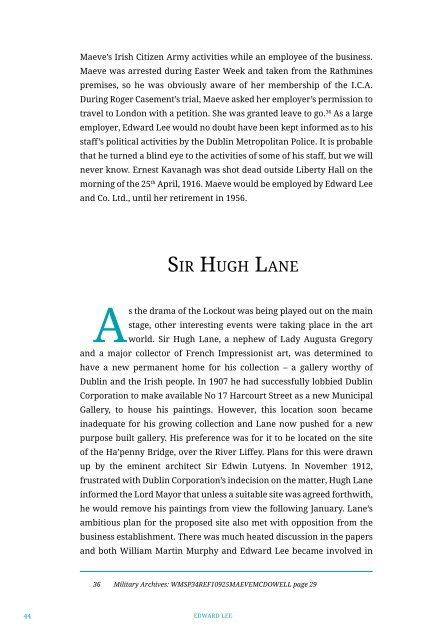Edward Lee
Edward Lee Book
Edward Lee Book
Create successful ePaper yourself
Turn your PDF publications into a flip-book with our unique Google optimized e-Paper software.
Maeve’s Irish Citizen Army activities while an employee of the business.<br />
Maeve was arrested during Easter Week and taken from the Rathmines<br />
premises, so he was obviously aware of her membership of the I.C.A.<br />
During Roger Casement’s trial, Maeve asked her employer’s permission to<br />
travel to London with a petition. She was granted leave to go. 36 As a large<br />
employer, <strong>Edward</strong> <strong>Lee</strong> would no doubt have been kept informed as to his<br />
staff’s political activities by the Dublin Metropolitan Police. It is probable<br />
that he turned a blind eye to the activities of some of his staff, but we will<br />
never know. Ernest Kavanagh was shot dead outside Liberty Hall on the<br />
morning of the 25 th April, 1916. Maeve would be employed by <strong>Edward</strong> <strong>Lee</strong><br />
and Co. Ltd., until her retirement in 1956.<br />
Sir Hugh Lane<br />
As the drama of the Lockout was being played out on the main<br />
stage, other interesting events were taking place in the art<br />
world. Sir Hugh Lane, a nephew of Lady Augusta Gregory<br />
and a major collector of French Impressionist art, was determined to<br />
have a new permanent home for his collection – a gallery worthy of<br />
Dublin and the Irish people. In 1907 he had successfully lobbied Dublin<br />
Corporation to make available No 17 Harcourt Street as a new Municipal<br />
Gallery, to house his paintings. However, this location soon became<br />
inadequate for his growing collection and Lane now pushed for a new<br />
purpose built gallery. His preference was for it to be located on the site<br />
of the Ha’penny Bridge, over the River Liffey. Plans for this were drawn<br />
up by the eminent architect Sir Edwin Lutyens. In November 1912,<br />
frustrated with Dublin Corporation’s indecision on the matter, Hugh Lane<br />
informed the Lord Mayor that unless a suitable site was agreed forthwith,<br />
he would remove his paintings from view the following January. Lane’s<br />
ambitious plan for the proposed site also met with opposition from the<br />
business establishment. There was much heated discussion in the papers<br />
and both William Martin Murphy and <strong>Edward</strong> <strong>Lee</strong> became involved in<br />
36 Military Archives: WMSP34REF10925MAEVEMCDOWELL page 29<br />
44 <strong>Edward</strong> <strong>Lee</strong>


